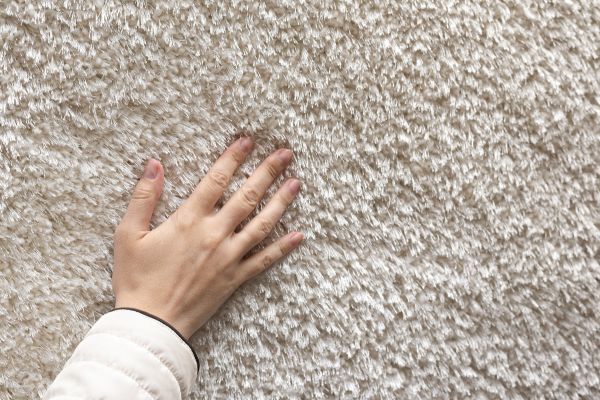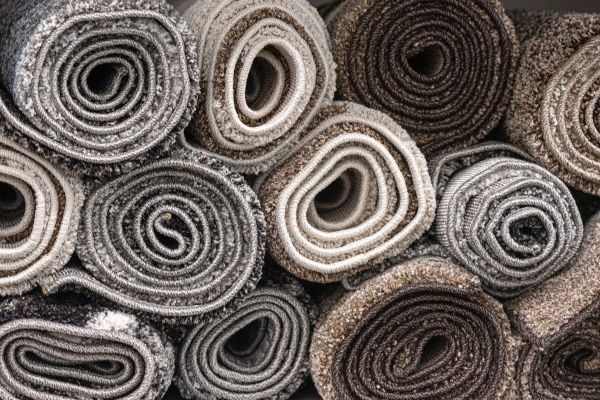If you have ever had to replace your carpet, then you know how difficult it can be to dispose of old carpets or rugs. But what are the options to dispose of your carpet responsibly?
Carpet fibers are typically made of plastic-based materials such as nylon, polypropylene, and polyester. These synthetic fibers are cheap, hardwearing, and can hold color and form. Natural fibers, such as wool, can also be used to make carpets, giving them a greater quality and longer lifespan, but doing so is more expensive and consequently less common.
The problem with these synthetic fibers in carpets is that they are not biodegradable and pose a significant challenge in landfills. They can take hundreds of years to decompose, release toxic chemicals, and contribute to greenhouse gas emissions. Plus, when carpets are disposed of in landfills, they take up an enormous amount of space.
To mitigate this problem, carpet recycling is being considered as a solution. However, the process is complex and expensive, making it difficult to implement on a large scale. As a result, carpet recycling is in its infancy, and services are not always available. However, depending on where you live, things are changing.
What are Carpets Made from?
Carpets are typically made from a combination of natural and synthetic materials. The specific composition varies depending on the carpet’s type and quality. It’s important to note that the composition of carpets can vary based on the manufacturer, type of carpet, and intended use.
Carpets are made up of two main parts:
- a face fiber – the part that you see and walk on
- a backing system – the part that holds the face together and gives it strength
Face Fibers are commonly made from:
- Nylon: Nylon is a popular synthetic fiber used in carpets due to its durability, stain resistance, and resilience. It is often found in residential and commercial carpets.
- Polyester: Polyester fibers offer softness, vibrant colors, and good stain resistance. It is commonly used in residential carpets.
- Polypropylene/Olefin: Polypropylene is a synthetic fiber known for its stain resistance and affordability. It is often used in indoor/outdoor carpets and low-cost options.
All of these materials are types of plastic. These plastic-based fibers are cheap, hardwearing, and comfortable underfoot, making them popular. The face fiber can also be made from natural fibers such as wool or cotton and can even be made from a blend of synthetic and natural fibers.
Backing systems are usually made from either latex or polyvinylchloride (PVC). These may also be layered with materials like polypropylene.
Carpets are a mix of many different materials, making them difficult to recycle.

Why Carpets Don’t Belong in Landfills
According to the Carpet America Recovery Effort (CARE), the carpet recycling industry’s primary organization in the United States, the overall carpet recycling rate has been around 5% in recent years. This means approximately 95% of post-consumer carpet goes to landfills or is incinerated. In 2018, the United States generated 3.4 million tons of carpet waste, with only 310,000 tons being recycled and the rest sent to landfills or incinerated.
Carpet waste has a significant negative impact on the environment, similar to that of any other plastic. When carpets are sent to landfills, they can take hundreds of years to break down and release greenhouse gases and potentially toxic pollutants.
The chemicals used in carpet manufacturing, such as synthetic fibers and complex weaves, can contribute to the problem of microplastics in the environment, which are harmful to the food chain. Improper disposal of carpets can also lead to dangerous chemicals leaching into the ground and water. It’s essential to recycle and dispose of old carpets responsibly to minimize their detrimental impact on the environment.
Why is Carpet So Hard to Recycle?
As described above, carpets are typically made of synthetic fibers like nylon, polypropylene, and polyester, with nylon being the most common. To recycle carpets, these fibers must be identified and sorted separately. Then the backing materials, often made of plastic, must be removed and separated. The complex fibers and chemical treatments make carpet recycling difficult and really expensive.

How is Carpet Recycled
Carpet recycling is a complex process that involves several stages. First, the carpet is collected and sorted, often using an infrared light spectrometer to identify the different materials. The carpet is then separated by cutting the backing from the face or shredding and washing. The individual materials are then further processed or sent to specialist plants. For example, polypropylene can be melted down into pellets and sent to other companies, nylon face fibers can be turned into new carpeting, and other plastics are downcycled into low-grade plastics.
Below is an example of the steps required:
- Collection: Used carpets are collected from various residential, commercial, or industrial sources. These carpets may be obtained through partnerships with retailers, installers, or waste management companies.
- Sorting and Separation: The collected carpets are transported to a recycling facility, where they undergo sorting and separation. This step involves removing any non-carpet materials, such as adhesives, padding, and metal fasteners. Different carpet types, such as nylon, polyester, or wool, are usually separated for processing.
- Pre-processing: Once the carpets are sorted, they go through a pre-processing stage. This typically involves shredding or cutting the carpet into smaller pieces or strips. Padding materials may also be separated and processed separately.
- Fiber Extraction: In this step, the carpet materials are processed to extract the fibers. Different techniques are used depending on the type of carpet and fiber composition. For example, heat or chemical methods may be used to separate the fibers from the backing material. The extracted fibers are then cleaned and processed to remove any impurities.
- Recycling or Repurposing: After the fibers are extracted and cleaned, they can be recycled or repurposed in various ways. The specific recycling methods can differ depending on the carpet fiber type. Here are some common recycling options:
- Fiber Recycling: The carpet fibers can be transformed into raw materials for the production of new carpets or other textile products. They may be processed into pellets or fibers that can be spun into new yarns.
- Energy Recovery: In some cases, carpets that cannot be effectively recycled into new products may be used as a source of energy through incineration or co-processing in cement kilns.
- Other Applications: Carpet materials can also be repurposed for non-textile applications. For example, the fibers may be used in composite materials for construction or as filler in various products.
- Product Manufacturing: The recycled carpet materials are then used in the manufacturing of new carpets, textiles, or other products. These products may incorporate a percentage of recycled carpet fibers, reducing the need for virgin materials and minimizing environmental impact.
What is recycled carpet used for?
Recycled carpet can be used for a variety of products, with the most common being engineered resins used for car parts and traffic signs. Other uses include new products for fronting and backing, small rug mats, furniture batting, concrete filler, road underlayment, and geotextiles for soil retention and sod reinforcement. The cost of separating and processing has traditionally made carpet recycling less viable, but with the rising price of virgin resources, demand for carpet recycling may increase.
Upcycling is also an eco-friendly option for reusing old carpet, with ideas such as making area rugs, car floor mats, and pet crate liners. You can find some great examples later in this post.
Where to Buy Recycled Carpet?
Even though carpet is not always made into new carpet, it’s still a good idea to buy carpet that has been made using recycled content. More often, recycled carpets or rugs are made from recycled nylon or recycled polyester. Buying recycled carpet is an eco-friendly choice that helps reduce waste and conserve resources.
When it’s time to replace your old carpet, here are some things to consider:
- Try sourcing as-new second-hand carpets. You might even save yourself some money in the process.
- Ask your local recycled supplier for recycled carpet options.
- Search available options for recycled carpets near you.
By choosing recycled carpet, you are helping to decrease landfill waste and support sustainable practices in the carpet industry.
How to Dispose of Carpets and Rugs
The best thing you can to to find out how to dispose of carpets responsibly is to search for carpet recycling centers in your area. It will help ensure that your old carpets are recycled or at least disposed of in an environmentally responsible way.
The first option to explore is whether or not your carpet can be donated. This is more likely to be successful if you have offcuts from new carpet rather than a used carpet that is 20 years old. However, if it’s in good condition, it’s still worth exploring. If you cannot donate it then the next step is to look for carpet recyclers. There are several options, but I suggest starting with your local flooring company to see what they can offer. Keep reading for more info.
Donate Old Carpets
If it is in very good condition, then there may be options to donate it. If you have excess carpet from a new installation, consider donating it to a charity specializing in building or home restoration, such as the Habitat for Humanity ReStore. Make sure to keep the carpet intact and contact your local chapter for their guidelines on accepted sizes.
Unfortunately, many non-profit organizations do not accept used carpets due to health and safety concerns, but animal shelters may welcome donations of old carpet remnants to line kennels.
Local flooring companies may dispose of old carpets
Local flooring companies may assist in properly disposing old carpets and rugs by offering recycling programs or pick-up services for a fee. It’s important to contact them beforehand. Some companies may only provide this service to paying clients, while others may have restrictions on the size and condition of the carpet. Some may even offer a removal service which can be quite helpful.
Junk removal companies will dispose of carpet for you.
Junk removal services can be a convenient option for disposing of old carpets and rugs. These services offer to pick up and haul away carpeting from any room in your home or office, saving you the hassle of carrying heavy rolls of carpet. Be sure to check with them to find out more about their recycling services, as some may simply dispose of the old carpet in landfill.
Check With Your Local Waste Management Company
Another option is to check with your local waste management company about carpet disposal or recycling. Look up your waste management company’s contact information online or in the phone book. You can even call or email them and ask if they accept old carpets and rugs for recycling or disposal. Check their guidelines or requirements for preparing the carpet for disposal or recycling before go.
Remember to always check with your local waste management company before disposing of any bulky or potentially hazardous items to ensure proper handling and disposal.
Manufacturers with Take-Back Programs
There are a number of manufacturers that have established take-back programs for carpets. One example is Interface Flooring. They take back carpet and recycle it into new floor coverings in a closed-loop recycling process diverting millions of pounds of used carpet from landfills. Unfortunately, many of these programs, are limited to commercial companies, but it is always worth checking.
Search Directories for How to Dispose of Carpet
Search these directories to find recycling services where you live:
- USA and Canada – CARE carpet recycler directory – CARE (Carpet America Recovery Effort), a non-profit organization established to promote carpet recycling.
- UK – Carpet Recycling UK – a non-profit membership association working with manufacturers, distributors, contractors, retailers, fitters and the waste sector to divert carpet waste from landfill.
- Australia – Check with Planet Ark for business recycling options and look into reuse applications for domestic.
Other Ways to Reuse Old Carpets and Rugs
If you don’t have access to a recycling service for your old carpets there are plenty of other ways to dispose of your old carpets before tossing them into landfill.
Use Old Carpet To Keep Pets Happy
You can repurpose old carpets to keep your furry friends happy and comfortable. Cut old carpets into the desired shape and size to create comfortable pet beds or mats for them to lay on. Make sure to clean the carpets thoroughly before using them for your pets, as well as regularly washing them to ensure your pet’s safety and health. Here are some ideas:
- Old Carpets to Weather-Proof the Kennel – If you have an outdoor kennel for your pets, reusing old carpet can be a great way to weather-proof it. This can provide insulation for your pets against cold or damp ground while also making the kennel more comfortable for them to rest in. All you need for this project is an old carpet, a staple gun, a utility knife, and a waterproof sealant spray if desired.
- Old Carpets as Cat Scratches – Old carpets can be repurposed as cat scratches by turning them into a scratching post for your cat. To create a cat scratcher, you will need an old carpet, a wooden post, a saw, a staple gun, and some glue. First, cut the carpet into strips that are long enough to wrap around the wooden post. Then, wrap the strips around the post and staple them in place. Be sure to cover the post completely with the carpet strips. Finally, apply some glue to the top of the post and sprinkle it with catnip to encourage your cat to use it. Be sure to use a sturdy wooden post and check that it’s securely attached to the base to prevent it from falling over and potentially injuring your cat.

Use Carpet Scraps To Move Heavy Furniture
If you have some leftover carpet scraps lying around, you can use them to move heavy furniture with ease. You can simply cut a piece of carpet the size of a piece of furniture you need to move. Another idea is to cut the carpet into small pieces and attach it to the bottom of furniture, like chairs, with the carpet fibers facing the floor to protect your timber flooring.
Use Old Carpets as a Rug
Reusing old carpets as a rug is a cost-effective, durable, and eco-friendly option. To prepare an old carpet for use as a rug, start by cleaning it thoroughly and allowing it to dry completely. Next, cut the carpet to the desired size and shape, and use a carpet edging tool to finish the edges. When choosing the area to place the rug, consider high-traffic areas that could benefit from extra cushioning.
Use Old Carpets as Floor Mats for Your Car
Another great option for repurposing old carpets is to make car floor mats. Car floor mats can be quite expensive, so this is also a good way to save money. Here’s a simple guide to help you get started:
- Measure the floor of your car to determine the size of the mats you need.
- Use a marker or chalk to outline the shape of the mats on the old carpet.
- Cut the carpet along the outline using sharp scissors or a utility knife.
- Trim any excess carpet to ensure a perfect fit.
- Use a hot glue gun or strong adhesive to secure the edges of the carpet and prevent fraying.
- Place the mats in your car and adjust as needed.
Old Carpets as Sound Absorbers
Old carpets can be repurposed as sound absorbers, providing a solution for noise pollution. By placing small pieces of carpet under appliances like washers and dryers, the noise level can be significantly reduced. Additionally, carpet can be used as muffling mats in garages or workshops, reducing the noise level of power tools and other machinery. These creative and practical uses not only reduce waste but also improve the acoustics of your home or workspace.
Cushion Your Knees While Working
Using a section of carpet when you need to kneel down for a job like gardening can save you a lot of pain. It’s a useful way to repurpose some old carpets or even rugs and mats. You simply measure the size that works for you, cut the carpet and either sew the edges or put some hot glue on them to stop them from fraying.
If you enjoyed this guide on how to dispose of carpets, you might like some of our other guides.














